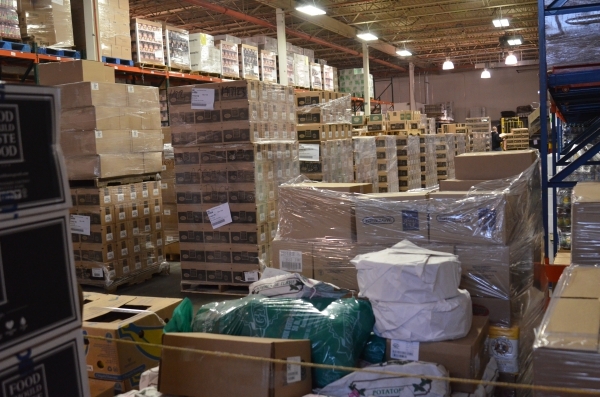BRATTLEBORO — A few weeks ago, I was having lunch at The Works when a woman came in and talked with the manager. Shortly thereafter, the manager went to the back and reemerged with three huge garbage bags full of bagels.
When I asked the manager about this, he informed me that The Works contributes its day-old bagels - as long as they're still fresh - and other food regularly to soup kitchens and shelters in the area.
I must admit that although I've lived in Brattleboro all my life and have interacted with soup kitchens and shelters, I'd never focused on contributions like these.
So I decided to learn more and made some wonderful discoveries about such efforts that seek to address a significant national and international problem.
What follows is just a sampling of what I discovered.
* * *
According to the United Nations, roughly a third of food produced each year for human consumption ends up lost or thrown away - 1.2 billion tons of it.
The average person in North America and Europe throws away 250 pounds of food every year, compared to 20 pounds in developing countries.
In talking with Richard French, the café's founder, and Susan Daniels, one of the managers, I learned that the woman I had seen picking up bagels and her husband are volunteers at the Drop-in Center.
By making such contributions, French has worked hard to make The Works what he calls “a community-conscious café.” The company also contributes its compost to local animal farms.
Across the street, Amy's Bakery freezes its day-old baked goods and similarly provides them for community meals.
One of the philanthropic organizations providing such meals is St. Brigid's Kitchen. In talking with Carolyn Pieciak, the manager, I learned that the kitchen picks up bread, pies, and cake four times a week from Hannaford.
St. Brigid's Kitchen also has received assistance from Rouleau-Holley's Tae Kwon Do. Each year Rouleau-Holley's sponsors a student competition. The entry fee: 10 pounds of food, which goes to St. Brigid's Kitchen and to the Keene Community Kitchen.
Loaves and Fishes receives its food from the Brattleboro Food Co-op, Dottie's Discount Foods, Price Chopper/Market 32, and Wild Carrot Farm, in addition to the Vermont Food Bank, and it receives flowers for its tables from Windham Flowers.
The Senior Center provides Loaves and Fishes with cooked meals, Thompson House occasionally makes sandwiches, and Bill Ames' farm used to provide lambs, with the butchery services provided by Loaves and Fishes itself!
Bob Oeser, a long-time organizer at Loaves and Fishes, stated that some recipients of lunches there have gone on to grow food and bring in eggs for the meals. Volunteers also have baked cookies, brownies and banana bread.
The government facilitates these contributions by offering some tax credits. Of course, the recipients often have significant capacity issues. Not all of this food can be utilized.
* * *
Central to many of these activities, and a prime recipient of grocery store produce, is the Vermont Foodbank. The Foodbank distributed 12 million pounds of food last year.
In addition to donating its bakery products directly to charitable organizations which serve meals to those in need - as it does with Loaves and Fishes - Price Chopper (now Market 32) donates food commodities through the Foodbank, which picks up the food regularly and delivers it to soup kitchens and shelters that the organization has vetted.
Last year, the regional chain's Vermont stores provided more than 300,000 pounds of food through the Foodbank.
An important component of the Foodbank's work is its “gleaning program,” where its volunteers, sometimes school groups, work with local farms, such as Harlow Farm in Westminster, during the entire growing season to harvest crops that might otherwise go to waste.
One woman, Lani Wharton of Putney, has made it a tradition on her birthday to invite her friends to join her in this generous effort. Over the past three years, she's brought 15 to 20 friends to celebrate with her by gleaning at Harlow Farm.
The Food Bank commemorates apple season with the “Pick for Your Neighbor” program, where those picking apples are encouraged to pick all they want but then to contribute part of their pickings to the Foodbank. In our area, participating orchards include Dwight Miller Orchards and Scott Farm in Dummerston, and Green Mountain Orchards in Putney.
Still another of the Foodbank's initiatives is the farmers'-market-like monthly produce events at hospitals and schools.
Don, suffering from a serious heart condition, unable to work and needing a transplant, was informed that his name could not be placed on the transplant list until his diet improved. This was more than challenging with his limited income.
But Don heard about these Foodbank-sponsored food produce events, attended many, and now, with his diet significantly improved, is on the transplant list.
Let me close with a lovely quote I saw recently.
“It is better to give than it is to receive. It is bad to give and not to receive. It is even worse to receive and not to give.
“But the best of all is at once to give and to receive. Love, the most inspiring and glorious of human emotions, is the simultaneous process of giving and receiving.”
That quote beautifully captures the spirit of these remarkable efforts.
